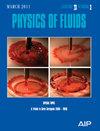Prophet modeling for oil production forecasting in an enhanced oil recovery field
IF 4.1
2区 工程技术
Q1 MECHANICS
引用次数: 0
Abstract
Accurate daily oil production forecasting is essential for efficient reservoir management and investment strategy. Forecasting oil production in enhanced oil recovery (EOR) and conformance-dominated fields is a complex process due to the nonlinear, voluminous, and often uncertain nature of reservoir parameters and hidden factors. As a result, conventional tools such as decline curve analysis frequently fail to accurately predict daily oil production in conformance-controlled areas. In contrast, machine learning works efficiently for large datasets, even if the parameter values are unknown. The current study employs a Prophet time series forecasting method for five oil production wells in an EOR applied field, but it fails to achieve the desired sweep efficiency. This study compares the results of conventional decline curve analysis (DCA) and popular autoregressive integrated moving average time series forecasting methods with the Prophet model. This is the first attempt to use Prophet for oil well production forecasting, where polymer flooding is used. In all, 60% of the data are used for training, and the remaining 40% are used for testing. The Prophet shows the best performance for all the wells. This study is also the first to handle shut-in data using the Prophet model for oil production. Well-2 achieves the highest accuracy after incorporating shut-in results, with an R2 score of 92%. The result shows that though the DCA performs reasonably well with higher linearity and trend stationary data, Prophet modeling shows superior results than conventional DCA for all EOR applied producing wells.先知建模用于强化采油田的石油产量预测
准确的石油日产量预测对于高效的油藏管理和投资战略至关重要。由于油藏参数和隐藏因素的非线性、大量且往往不确定,在强化采油(EOR)和一致性主导油田中预测石油产量是一个复杂的过程。因此,传统工具(如递减曲线分析)经常无法准确预测一致性控制区域的石油日产量。相比之下,即使参数值未知,机器学习也能高效地处理大型数据集。目前的研究采用了一种先知时间序列预测方法,用于 EOR 应用领域的五口采油井,但未能达到预期的扫井效率。本研究将传统的下降曲线分析(DCA)和流行的自回归综合移动平均时间序列预测方法的结果与 Prophet 模型进行了比较。这是首次尝试使用 Prophet 进行油井产量预测,其中使用了聚合物水淹法。总共有 60% 的数据用于训练,其余 40% 用于测试。在所有油井中,Prophet 的表现都是最好的。这项研究也是首次使用 Prophet 模型处理石油生产的停产数据。在加入关井结果后,2 号井的准确度最高,R2 得分为 92%。结果表明,虽然 DCA 在线性度和趋势静态数据较高的情况下表现尚可,但对于所有应用 EOR 的生产井,Prophet 模型的结果都优于传统 DCA。
本文章由计算机程序翻译,如有差异,请以英文原文为准。
求助全文
约1分钟内获得全文
求助全文
来源期刊

Physics of Fluids
物理-力学
CiteScore
6.50
自引率
41.30%
发文量
2063
审稿时长
2.6 months
期刊介绍:
Physics of Fluids (PoF) is a preeminent journal devoted to publishing original theoretical, computational, and experimental contributions to the understanding of the dynamics of gases, liquids, and complex or multiphase fluids. Topics published in PoF are diverse and reflect the most important subjects in fluid dynamics, including, but not limited to:
-Acoustics
-Aerospace and aeronautical flow
-Astrophysical flow
-Biofluid mechanics
-Cavitation and cavitating flows
-Combustion flows
-Complex fluids
-Compressible flow
-Computational fluid dynamics
-Contact lines
-Continuum mechanics
-Convection
-Cryogenic flow
-Droplets
-Electrical and magnetic effects in fluid flow
-Foam, bubble, and film mechanics
-Flow control
-Flow instability and transition
-Flow orientation and anisotropy
-Flows with other transport phenomena
-Flows with complex boundary conditions
-Flow visualization
-Fluid mechanics
-Fluid physical properties
-Fluid–structure interactions
-Free surface flows
-Geophysical flow
-Interfacial flow
-Knudsen flow
-Laminar flow
-Liquid crystals
-Mathematics of fluids
-Micro- and nanofluid mechanics
-Mixing
-Molecular theory
-Nanofluidics
-Particulate, multiphase, and granular flow
-Processing flows
-Relativistic fluid mechanics
-Rotating flows
-Shock wave phenomena
-Soft matter
-Stratified flows
-Supercritical fluids
-Superfluidity
-Thermodynamics of flow systems
-Transonic flow
-Turbulent flow
-Viscous and non-Newtonian flow
-Viscoelasticity
-Vortex dynamics
-Waves
 求助内容:
求助内容: 应助结果提醒方式:
应助结果提醒方式:


